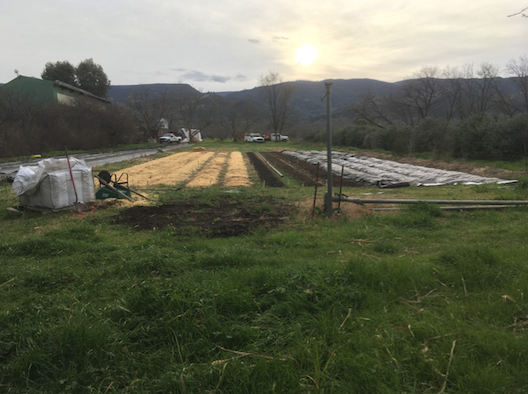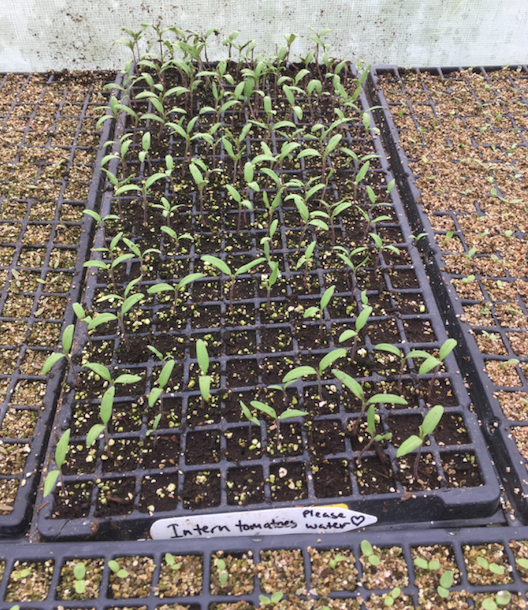Hi All! My name is Ben Culver and I am the newest intern at the farm. The other interns and I have started our own project and I’d like to share with you guys what we’re getting into!
We are starting a little market garden behind the mechanical shop, where some of past interns have also done projects. Right now we have twelve 100-feet by 2.5-feet beds prepared with various different treatments. Six of our twelve beds are largely inspired by Jean-Martin Fortier’s The Market Gardener. Fortier farms (or maybe more accurately, gardens) in Quebec on 1.5 acres with his wife, where they are able to produce enough to service around 200 CSA families and participate in weekly markets. They follow a minimum tillage approach and plant their crops at very high densities, both to get the highest possible production out of their small farm and to use the crops to shade out weeds.
After mowing down the Sudan grass that was covering the area and staking out the beds, we dug out the furrows between the beds and put that soil on top of each bed, raising our beds and providing them with loose, wormy soil. We then went on to cover four of our six Fortier-inspired beds with black tarps. We just did this in a break between the rains with the hope that the water would germinate a lot of the weed seeds in the upturned soil from the furrows. Thus, we plan to leave the tarps on the beds for a couple of weeks to kill the germinated weeds, eliminating a large portion of the weed competition for our upcoming crops. The other two beds we have amended with some compost and are planning to plant some turnips in one bed, while intercropping cabbage and radishes in the other.
The photo above is a recent photo of the garden. The four beds covered with tarps on the right are the Fortier-inspired beds . The five beds on the left covered with straw mulch are the no-till beds.
On the remaining six beds we are working closely with Full Belly owner, Paul Muller. These beds are following a no-till approach, practiced on a number of different farms, including Singing Frogs Farm in Sebastopol. After mowing and weed-wacking we applied a number of different amendments including a fungal compost that is the product of a past intern project. Here we did not dig out the furrows, opting to maintain the microbial communities in the soil as much as possible. We hand-spread a cover crop mix on 3 of the 6 beds and then applied a significant amount of compost on top of each bed, amounting to about an inch or so thick. After this we covered 5 of the 6 beds with some of our organic straw as mulch to shade out the weeds and keep the soil moist and soft beneath (leaving one experimental bed with the cover crop mix without the straw cover). You can see that we have begun to put straw in the furrows of these beds for additional weed defense and once this straw decomposes we will put it on top of our beds as additional organic matter.
The cover crop mix we applied on our no-till beds contains oats, rye grass, two types of winter peas, five different types of clover, and wheat.
The general theme underlying this entire project is to see if by minimally working the soil, we can cultivate a rich and diverse microbial community that will allow us to produce high quality and higher quantities of produce on less land. This bio-intensive approach certainly requires more human-power and time, as we are not using any tractors in the garden (except for when we initially mowed down the grass). Tractors intrinsically create an interesting trade-off. They naturally compact the soil and using them for tilling each season disrupts the soil microbiology, especially fungal networks. Yet, they save a ton of time and work. Our project is putting a lot of faith in biology, as we are trying to apply our collective understanding of the ecological system of which we are a part to optimize the output of our little piece of land.
Some early girl tomatoes we sowed in January.
One thing that I will candidly admit, is this is not easy! There’s parable I’ve heard about a man planning on moving to the United States because he heard the roads were paved in gold. However, when he arrived, he learned three things: the roads weren’t gold, they weren’t paved, and he would be the one paving them. When you begin to dive into a project such as this, you become that man! At the onset you have dreamy hopes and plans for your project, but then, as always, reality hits and challenges arise. Finite time mixed with inexperience make for a dangerous cocktail when it comes to planning. But while our garden isn’t made of gold, it has already proved to be a great learning experience and a lot of fun. Stay tuned to hear more about it and hopefully see some of our produce at markets!
—Ben Culver



